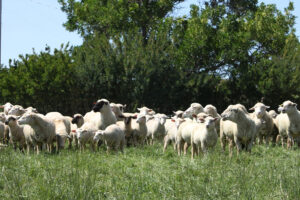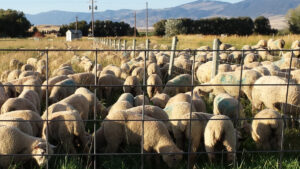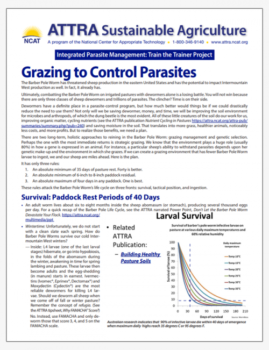Grazing to Control Parasites
By Dave Scott, NCAT Agriculture Specialist
The Barber Pole Worm has threatened sheep production in the eastern United States and has the potential to impact Intermountain West production as well. In fact, it already has.
Ultimately, combatting the Barber Pole Worm on irrigated pastures with dewormers alone is a losing battle. You will not win because there are only three classes of sheep dewormers and trillions of parasites. The clincher? Time is on their side.
Dewormers have a definite place in a parasite-control program, but how much better would things be if we could drastically reduce the need to use them? Not only will we be saving dewormer, money, and time, we will be improving the soil environment for microbes and arthropods, of which the dung beetle is the most evident. All of these little creatures of the soil do our work for us, improving organic matter, cycling nutrients (see the ATTRA publication Nutrient Cycling in Pastures) and saving moisture in the soil. That translates into more grass, healthier animals, noticeably less costs, and more profits. But to realize those benefits, we need a plan.
There are two long-term, holistic approaches to reining in the Barber Pole Worm: grazing management and genetic selection. Perhaps the one with the most immediate returns is strategic grazing. We know that the environment plays a huge role (usually 80%) in how a gene is expressed in an animal. For instance, a particular sheep’s ability to withstand parasites depends upon her genetic make-up and the environment in which she grazes. If we can create a grazing environment that has fewer Barber Pole Worm larvae to ingest, we and our sheep are miles ahead. Here is the plan.
It has only three rules:
1. An absolute minimum of 35 days of pasture rest. Forty is better.
2. An absolute minimum of 6-inch to 8-inch paddock residual.
3. An absolute maximum of four days in any paddock. One is best.
These rules attack the Barber Pole’s life cycle on three fronts: survival, tactical position, and ingestion.
Survival: Paddock Rest Periods of 40 Days
- An adult worm lives about six to eight months inside the sheep abomasum (or stomach), producing several thousand eggs per day.
- Wintertime: Unfortunately, we do not start with a clean slate each spring. How do Barber Pole Worms survive our cold Intermountain West winters?
- Inside: L4 larvae (one of the last larval stages) hibernate, or go into hypobiosis, in the folds of the abomasum during the winter, awakening in time for spring lambing and pasture. These larvae then become adults and the egg-shedding (in manure) starts in earnest. Ivermectins (Ivomec, Eprinex, Dectomax) and Moxydectin (Cydectin) are the most reliable dewormers for killing L4 larvae. Should we deworm all sheep when we come off of fall or winter pasture? Remember the concept of refugia. (See the ATTRA tipsheet, Why FAMACHA Score?)
No. Instead, use FAMACHA and only deworm those that score 3, 4, and 5 on the FAMACHA scale. - Outside: Some L3 larvae survive months of frigid temperatures, especially under snow.
- Inside: L4 larvae (one of the last larval stages) hibernate, or go into hypobiosis, in the folds of the abomasum during the winter, awakening in time for spring lambing and pasture. These larvae then become adults and the egg-shedding (in manure) starts in earnest. Ivermectins (Ivomec, Eprinex, Dectomax) and Moxydectin (Cydectin) are the most reliable dewormers for killing L4 larvae. Should we deworm all sheep when we come off of fall or winter pasture? Remember the concept of refugia. (See the ATTRA tipsheet, Why FAMACHA Score?)
- Summertime: Research in Australia has discovered that 90% of Barber Pole L3 infective larvae die within 40 days after emerging from eggs when daytime highs are above 90° F or 35° C. (WormBoss, 2018 )
- In the summer, when we rest our pasture 40 days or more, we can avoid the peak of Barber Pole larvae populations. It’s that easy!
- A 40-day rest period also sets the stage for optimal plant-nutrient cycling, especially if you graze half and trample half of the forage. This reduces the need for fertilizing, especially nitrogen. (See the ATTRA publication Nutrient Cycling in Pastures.
- Conversely, setting grazing rest at 20 to 25 days (a common practice), synchs grazing periods with peaking parasite populations. Let’s avoid that.
- Another effective way to curb parasites is to hay a pasture, which desiccates the parasite larvae. Then, after an adequate rest period, graze that pasture.

Ready to move. Six to eight inches of residual. Photo: Pat Hansen
Tactical Position: Leave Behind Six to Eight Inches of Grass
- The vast majority of Barber Pole Worm L3 larvae only crawl three to four inches up the grass stem or leaf.
- If you graze down to six to eight inches and move your sheep, you have evaded a lot of infective larvae. Let them die.
- Leaving behind sufficient residual also gives your grass a jump start in regrowth. You have left behind lots of photo-collectors (leaves). That is definitely not wasted grass.
Ingestion: Leave Before the Larvae Arrive

L3 Infective larvae waiting for your sheep to ingest them. You can avoid them by exiting paddocks before L3 larvae get to their perch (four to nine days). Photo: Langston University Research and Extension
It takes four to nine days after deposition for eggs in the fecal pellet to hatch into L3 larvae and then to crawl up on to their perch in the grass leaf.
If you move animals from the paddock before four days, you miss the latest crop of L3 larvae. Simple as that.
One- to four-day paddock periods also give your irrigated (or rain-fed) grass production a huge boost. Try it and be amazed. Who doesn’t want more carrying capacity?
Graze to Control: The Sum is Greater than the Parts
- Grazing antagonistically with the Barber Pole Worm’s lifecycle yields big dividends. Use 40-day rest periods, long-length paddock residuals, and short grazing periods in combination to maximize effective grazing control. These same three practices will greatly improve the health of your soil and pastures. See the ATTRA publication Building Healthy Pasture Soils.
- The incorporation of tannin-producing plants like birdsfoot trefoil in Northeast pastures has been shown to reduce both fecal egg counts and FAMACHA scores, especially in conjunction with copper oxide wire particles (Parent et al., 2016). This may be worth investigating, especially in Utah, where birdsfoot trefoil grows relatively well. However, it is sometimes difficult to establish (Brummer et al., 2016).
- Multispecies grazing: In this situation, the Barber Pole Worm ends its life in a bovine’s belly without shedding a single egg to your pasture. The same applies in reverse to bovine parasites (such as Ostertagia) that get vacuumed up by sheep. Can you employ this as a grazing strategy? See the ATTRA publication Multispecies Grazing: A Primer on Diversity.

Fence-line weaning begun with ewes on the right and lambs on the left. Note that all heads are down, grazing. After 48 hours, the lambs were gently moved away. Not one bleat and little stress. Photo: Dave Scott, NCAT
- Fence-line weaning is very effective in reducing lamb stress. Stress predisposes lambs to worm infection. This weaning strategy is not hard to do. Try it!
Summary
Changing the way you graze can be one of the best moves you make to confront the Barber Pole Worm. To top it all off, there is little the worm can do genetically in your lifetime to adapt to it. You win.
References
Brummer, Joe, Jennifer MacAdam, Glen Shewmaker and M. Anowarul Islam. 2016. Establishing Birdsfoot Trefoil in the Mountain West.
Parent, Molly, Tatiana Stanton, and Betsy Hodge. 2016. The Effect of Birdsfoot Trefoil Forage on Barber Pole Worm in Sheep and Goats in Northern NY.
WormBoss. 2018. Factors Contributing to Paddock Contamination with Worms.
Grazing to Control Parasites
By Dave Scott, NCAT Agriculture Specialist
Published June 2018
©NCAT
IP565
Slot 592
This publication is produced by the National Center for Appropriate Technology through the ATTRA Sustainable Agriculture program, under a cooperative agreement with USDA Rural Development. This publication was also made possible in part by funding from the National Institute of Food and Agriculture, U.S. Department of Agriculture, under award number 2016-38640-25383 through the Western Sustainable Agriculture Research and Education program under subaward number EW 17-011. ATTRA.NCAT.ORG.


